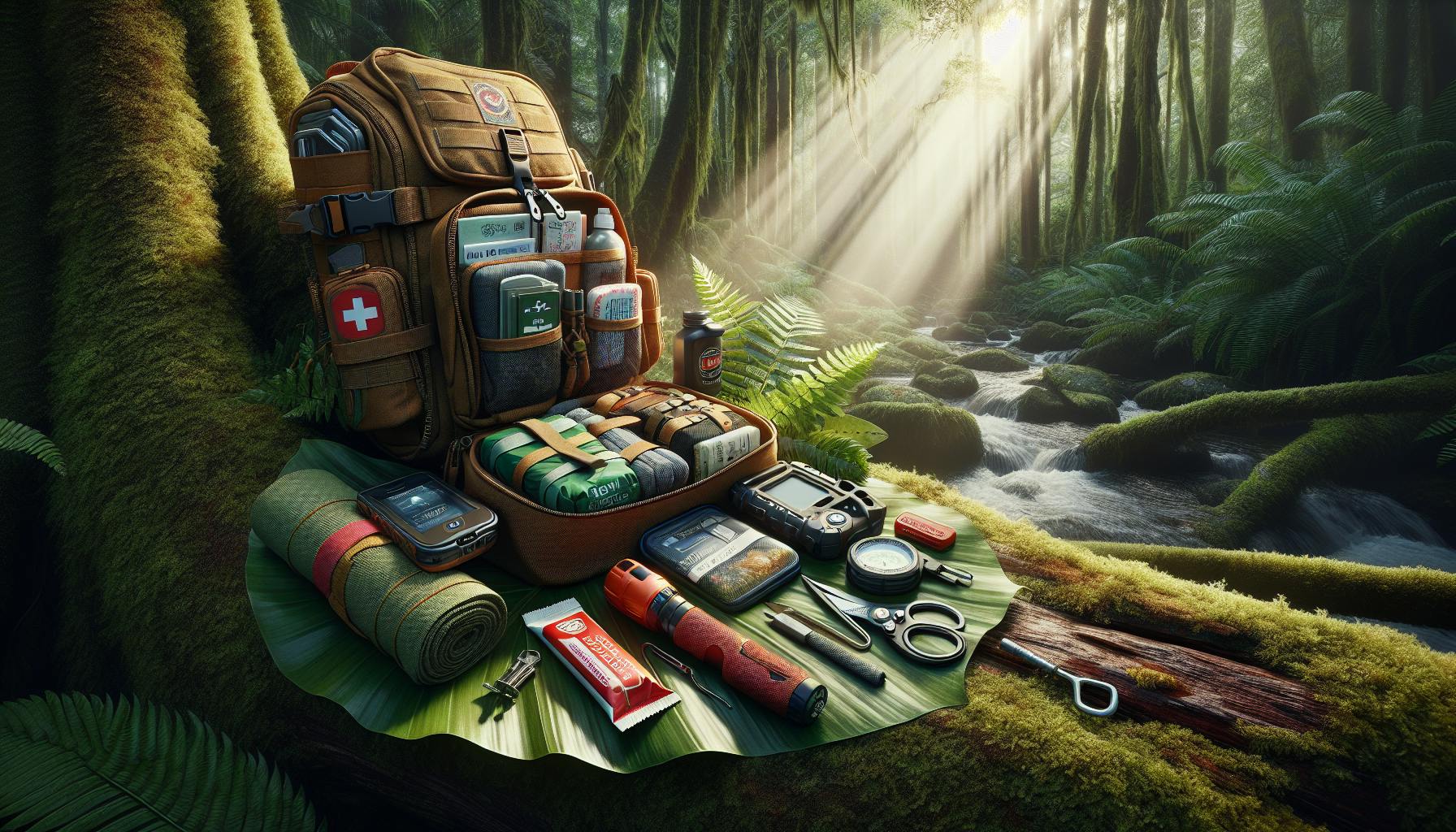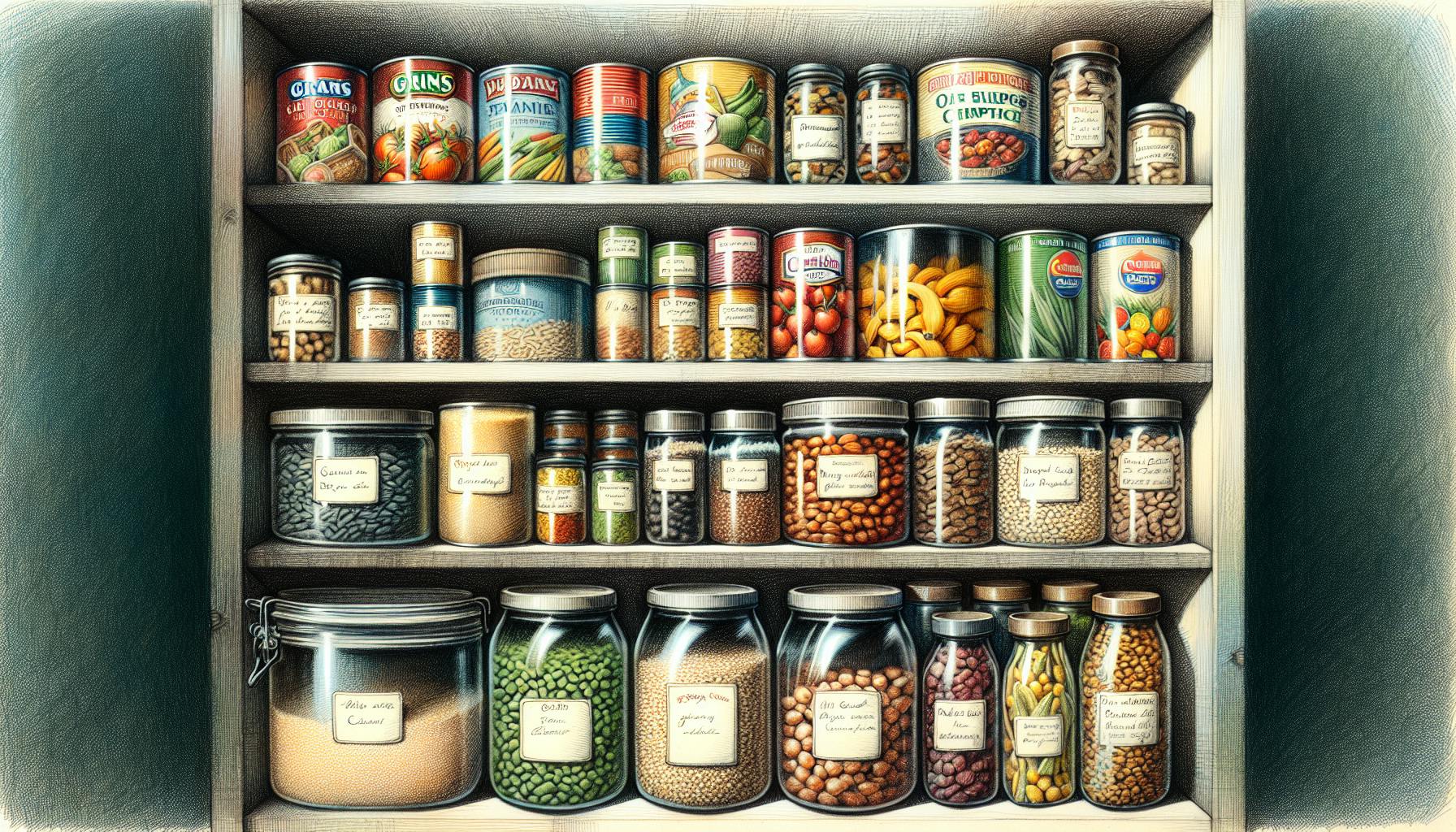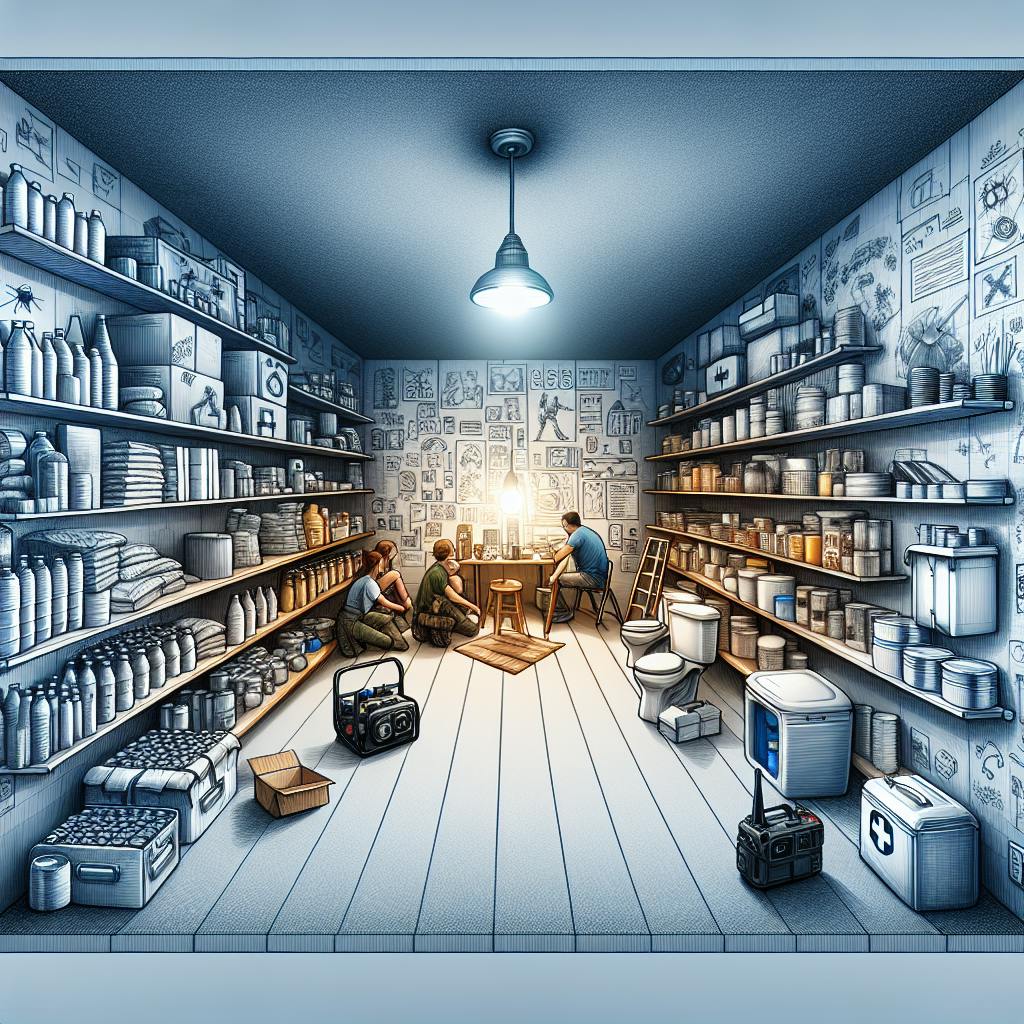When building an emergency food supply, most people would agree that shelf stability and nutritional value are crucial factors to consider.
By stocking up on a select group of non-perishable yet nutrient-dense foods, you can create a survival pantry that will reliably sustain you and your family during a crisis.
In this post, we'll explore the top 10 pantry staples for emergency preparedness. You'll discover the essential foods that don't require refrigeration, provide adequate hydration, and can be safely stored long-term.
Introduction to Essential Survival Foods
Essential survival foods are critical components of any emergency preparedness kit. Having the right foods stockpiled can provide sustenance during unforeseen events when access to fresh food is limited. This introductory section will highlight the basics of survival food storage and the key criteria for selecting shelf-stable foods that will last.
Understanding the Basics of an Emergency Preparedness Kit
An emergency preparedness kit should contain everything you need to survive for at least 3 days without access to food, water, or electricity. Food is one of the most vital components. The right survival foods are:
- Shelf-stable - Requires no refrigeration and has a long shelf life
- Packed with nutrients - Provides protein, vitamins, minerals
- Easy to prepare - Simple storage and cooking even during a crisis
- Tasty - Palatable to eat even when supplies run low
Stocking nutritious, long-lasting foods provides a safety net during unexpected emergencies like natural disasters or power outages.
Criteria for Selecting Survival Foods That Last a Long Time
When building an emergency food supply, carefully read expiration or best-by dates and store foods properly to maximize freshness. Prioritize shelf-stable items like:
- Canned goods - Fruits, vegetables, beans, soups, meats
- Dried foods - Granola, nuts, jerky
- Staples - Rice, oats, pasta, flour
- Comfort foods - Coffee, tea, powdered drinks
Avoid stockpiling perishables like fresh meats, dairy, or bread that require refrigeration. Focus on nutritious and filling foods that retain quality for years when properly stored.
Rotating and replenishing food supplies ensures they remain fresh and safe to eat when you need them most.
What are the top 10 survival foods?
When building your emergency food supply, focusing on shelf-stable items with a long expiration date is key. Here are 10 of the best survival food staples to stock up on:
- Whole grains like rice, quinoa, oats, and pasta. These are calorie-dense and packed with nutrients. Look for whole grain options when possible.
- Canned goods like vegetables, fruits, beans, soups, and meats. Canned items are convenient, affordable sources of essential nutrients. Prioritize lower sodium options.
- Nuts and seeds which are high in protein, fiber, and healthy fats. Stick to unsalted varieties in airtight containers.
- Dried beans and lentils are an excellent source of plant-based protein. They are inexpensive and have a long shelf life.
- Canned or jarred fruits and vegetables to get your daily dose of nutrients from produce.
- Shelf-stable milk, like powdered or canned milk, ensures you have a dairy source when fresh milk is in short supply.
- Comfort foods like coffee, tea, honey, maple syrup, and dark chocolate provide morale boosts.
- Beef jerky, canned tuna, salmon, or chicken for lean protein sources.
- Granola, protein, or fruit bars which are portable sources of nutrients.
- Multi-vitamins to fill any nutritional gaps and maintain health.
When stockpiling these essentials, be sure to rotate items, track expiration dates, and replenish any items you use. Having at least a 3 month supply is recommended. Prepare and stay safe!
What are the best food to stockpile?
When building your emergency food supply, focusing on shelf-stable items with a long expiration date is key. Here are some of the best survival food staples to stockpile in your pantry or emergency kit:
- Canned goods: Canned meats, fruits, vegetables, beans, and seafood are nutritious and convenient options that will last 2-5 years when properly stored. Opt for low-sodium varieties when possible.
- Grains: Whole grains like rice, quinoa, oats, and pasta have long shelf lives and provide essential carbs. Look for whole grain crackers, cereal, and flour as well.
- Nut butters: High in protein and healthy fats, nut butters like peanut butter can boost the nutritional value of your stockpile.
- Dried fruits and vegetables: Dried options like raisins, apples, carrots, potatoes, and onions rehydrate well for meals and provide key nutrients.
- Oils and fats: Vegetable, olive, coconut and other plant-based oils store nicely. Also stock up on shelf-stable nuts, seeds and nut butters.
- Water and drinks: Have at least 1 gallon of water per person per day plus powdered drink mixes like coffee, tea, electrolyte mixes, and powdered milk.
When building your emergency food supply, focus on nutrient-dense non-perishables with a long shelf life. Canned goods, whole grains, nut butters and dried fruits and veggies check all the boxes. And don't forget water!
What foods do you need for survival?
Having the right foods stockpiled can make a huge difference in an emergency situation. Here are some of the most essential items to include in your survival pantry:
Canned and Shelf-Stable Foods
Canned meats, fruits, vegetables, soups, and juices are important for stockpiling. Opt for low-sodium varieties when possible. Canned goods provide essential nutrients and can last 1-2 years when properly stored.
Other shelf-stable foods like peanut butter, crackers, cereal, and nuts are also good options. Make sure to check expiration dates and rotate your stock.
Staples
Salt, sugar, flour, oil, spices, coffee, and tea bags make up the basics you'll want to cook with. Properly stored white flour lasts 1-2 years. Whole wheat flour has more nutrients but doesn't keep as long.
Water
Having an emergency water supply is critical. Store at least 1 gallon per person for 3 days minimum. Create an emergency water supply and make sure you have plans to filter and disinfect water if needed.
When building your survival food supply, focus on nutrient-dense, non-perishable items that don't require refrigeration. Canned goods, shelf-stable staples, and an emergency water supply will help you get through a disaster scenario.
sbb-itb-b932644
What are 10 items in a survival kit?
Having the right items in your emergency preparedness kit can make all the difference in an unexpected crisis situation. Here are 10 essentials to include:
Flashlight and Extra Batteries
A flashlight allows you to navigate in the dark during a power outage. Make sure to pack extra batteries as well. LED flashlights are extremely bright and energy-efficient.
Whistle
A loud whistle can be used to call for help if you are trapped or lost. Choose one with a removable lanyard.
Dust Mask
Dust masks protect your lungs from smoke, fumes, and airborne debris. Have several N95 or N100 masks on hand.
Maps
Local maps help you identify alternate routes, landmarks, and potential shelter locations if you need to evacuate the area. Always keep paper maps as backup.
Manual Can Opener
A non-electric can opener allows you to access canned food when the power is out. The best ones require little effort to operate.
Battery-Powered Radio
Stay updated on the situation by listening to emergency broadcasts on a wind-up or battery-powered radio. Choose one with multiple power options.
Games and Puzzles
Boredom can be just as stressful as the disaster itself. Pack a deck of cards, books, puzzles, and other activities to keep children occupied.
First Aid Kit
A well-stocked first aid kit contains bandages, gauze, ointments, latex gloves, scissors, tweezers, thermometers, over-the-counter meds, etc. Know basic first aid.
These 10 items form an essential baseline for emergency preparedness. Customize your kit based on your family's unique needs and evolve it over time as situations change. The key is having critical supplies on hand before an emergency strikes.
The Pantry Essentials: Foods You Don't Have to Refrigerate
When building your emergency food supply, focusing on shelf-stable items that don't require refrigeration is key. These foods have a longer shelf life and will be there when you need them during a power outage or disaster scenario.
Canned Varieties Can Provide You with Essential Nutrients
Canned foods like beans, vegetables, fruits, meats, and seafood are nutritious additions to your survival pantry. Canned goods are processed for safe shelf storage and can provide protein, vitamins, and minerals. Focus on low-sodium varieties whenever possible and be sure to rotate stock.
Low-Sodium Options for Long-Term Health
Choosing low-sodium canned goods is important for maintaining heart health during an extended emergency situation. As we stock up on shelf-stable items like beans, soups, vegetables, and meats, select no-salt-added or reduced sodium options. This will help mitigate high blood pressure and other health issues over time. Moderating sodium intake promotes wellness.
Properly Stored Flour and Baking Essentials
Flour and other baking needs like yeast, baking soda, and powder can be stored in airtight containers in a cool, dark place for up to 6 months. Use oldest ingredients first and check for freshness before use. Proper storage prevents spoilage and ensures you can bake nutritious breads and treats during emergencies without refrigeration required.
Ways to Keep Bagged Salad Fresh
Pre-washed bagged salad greens require some creativity to stay crisp when refrigeration isn't available. Keep unopened bags cool as long as possible. Once opened, portion remaining salad into airtight containers, gently press out excess air, and store in the coolest location available. Adding a dry paper towel on top can help absorb moisture.
Having the right foods that don't require refrigeration is key to emergency preparedness. Stock up on shelf-stable essentials for nutrition and convenience when the power is out.
Hydration: Ensuring You Drink Enough Water Every Day
Water is essential for survival, especially in emergency situations when access to clean water may be limited. Having an emergency supply and practicing safe water habits are critical.
Creating and Storing an Emergency Water Supply
- Store at least one gallon of water per person per day for at least 3 days. Consider storing 2 weeks worth if possible.
- Use food-grade plastic containers with tight lids. Glass containers can break.
- Label containers with date and replace every 6 months.
- Store in a cool, dark place to prevent algae growth.
Safe Water Practices During a Crisis
- Boil water for 1 minute to kill bacteria if unsure of purity.
- Use water filtration devices to remove contaminants. Consider a gravity filter or pump filter.
- Practice good hygiene when handling water to prevent contamination.
The Role of Water Filtration and Purification
Water filtration removes particulates while purification kills pathogens. Methods include:
- Boiling: Bring water to a rolling boil for 1 minute to kill bacteria and viruses.
- Chlorination: Use household bleach if boiling is not possible. Add 1/8 tsp per gallon and let sit 30 minutes.
- Filters: Pump filters, straw filters, and gravity filters work well for small-scale needs.
Aim for at least one gallon of clean water per person per day. Having an emergency supply and using safe practices will help ensure you stay hydrated.
Food Preservation and Safety
Food safety and proper storage are critical for survival preparedness. Implementing effective food preservation techniques can extend shelf life and prevent spoilage or illness.
Ways to Store Food in the Refrigerator for Maximum Shelf Life
When storing food in the refrigerator, follow these tips:
- Group similar items together and store meats on the bottom shelf to prevent cross-contamination.
- Keep the refrigerator between 35-40°F. Use a thermometer and adjust as needed.
- Allow for airflow by not overpacking shelves.
- Store fruits and vegetables in high-humidity drawers.
- Place milk, eggs, and other perishables towards the back where temperatures are coldest.
- Wrap or cover foods tightly before storing.
Keeping Foods Fresh and Safe During a Power Outage
If the power goes out:
- Keep the refrigerator and freezer doors closed as much as possible to retain cold air.
- Use coolers with ice packs to store perishable items if it looks like power will be out for over 4 hours.
- Monitor temperatures with a food thermometer and throw away food if temperatures become unsafe.
- When in doubt, remember the phrase "When in doubt, throw it out!" to avoid foodborne illness.
Refrigerator and Food Safety: Safe Refrigerator Temperature
- A safe refrigerator temperature is 35-40°F to prevent bacterial growth. Monitor the temperature with an appliance thermometer.
- If the temperature rises about 40°F for over 2 hours, discard perishable foods like meat, poultry, fish, eggs, and leftovers.
- When restoring power, allow the refrigerator to reach 35-40°F before restocking food.
Long-Term Storage Techniques for Non-Perishable Items
When stockpiling non-perishable survival foods:
- Store in a cool, dark, and dry location like a basement or cellar.
- Ensure foods are approved for long-term storage with adequate packaging and preservatives.
- Label containers with contents and expiration or best-by dates.
- Use oxygen absorbers in sealed containers to prevent oxidation.
- Rotate stock using the "first in, first out" system to use oldest items first.
Implementing proper food safety and storage techniques will ensure you have wholesome foods available in an emergency situation. Monitor temperatures, packaging, contamination risks, and expiration dates closely. When in doubt, remember it's better to be safe than sorry to prevent foodborne illnesses.
Conclusion: Preparing Your Survival Food Pantry
Having a well-stocked survival food pantry is an essential part of emergency preparedness. By focusing on shelf-stable items that provide nutritional value, you can create a food supply to rely on when access to fresh foods is limited.
Here are some key takeaways when building your survival food stash:
- Prioritize essential survival food items with long shelf lives, such as canned goods, dried beans, rice, oats, and nut butters. Check expiration dates and rotate stock.
- Choose items that don't require refrigeration and are easy to prepare if the power goes out. Canned fish, meat, fruits and vegetables are convenient options.
- Opt for low-sodium and canned options to get vitamins and minerals when fresh produce is not available. Properly stored white flour, cornmeal, and pasta also have lengthy shelf lives.
- Store an emergency water supply and pay attention to proper food storage and safety, including refrigerator temperatures and food freshness during outages.
Building a survival food pantry takes time and planning, but is one of the most vital aspects of emergency preparedness. Continue learning ways to keep foods fresh and safe for the long term and to meet your household's unique nutritional needs, no matter the situation. The effort is well worth it for peace of mind.


